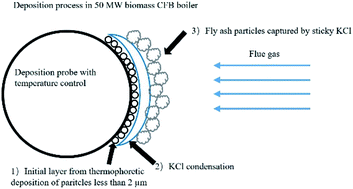Investigation of ash deposition dynamic process in an industrial biomass CFB boiler burning high alkali and chlorine fuel†
Abstract
Biomass direct combustion for power generation is used widely in China. The circulating fluidized bed (CFB) boiler has a lower combustion temperature and a wide fuel adaptability, which is suitable for biomass combustion. The dynamic process of ash deposition in a CFB boiler is different from that in a grate furnace because it has a lower combustion temperature and a higher flue gas flow. In this work, the dynamic process of ash deposition on a superheater in a 50 MW biomass CFB boiler was studied by a deposit sampling system at different deposition times. Multiple deposit samples with different deposition times were observed and analysed to obtain an indication of deposit changes with time to understand the entire deposit build-up process. This study differs from previous studies on ash deposition and the deposition process could be identified as occurring in three stages: (1) initial deposition, (2) KCI deposition and (3) capturing of fly ash particles. In the first stage, the temperature gradient near the superheater led to the deposition of fine particles smaller than 2 μm from the flue gas through thermophoretic deposition. In the second stage, the surface became rough, which led to an increase in gas-phase KCl condensation rate and the formation of a dense and continuous KCl layer after the initial deposition. In the third stage, KCI provided a sticky layer to capture larger particles in the flue gas. Thus, more large particles were captured in the flue gas and the KCl continued to condense. As the surface temperature was increased, the condensation rate of the gas-phase KCl decreased. The higher surface temperature enhanced KCI melting and captured more fly ash particles, which led to a rapid build-up of ash deposits on the heating surfaces.



 Please wait while we load your content...
Please wait while we load your content...